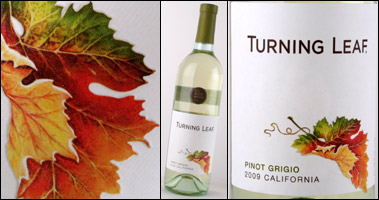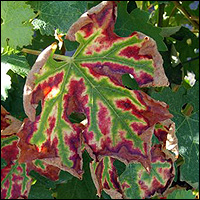A fall morning looking out the driveway of the winery. I love Napa in the fall. I think the landscape is most beautiful when all the vineyard leaves are changing. It's a small window, maybe 3 weeks between the end of harvest and beginning of winter when everything is rich with color.
During this time, the ground is bright green from the rain, the vines still have plenty of yellow and orange (or red) leaves. When the window closes, all the leaves will fall and the only color left will be brown. And frosty white.
Paradoxically, the most beautiful bright red leaves are the most diseased. What makes for a pretty picture usually also makes lower quality wine.

This vibrantly colored leaf has a virus called Leaf Roll. Vines that have Leaf Roll make lower quality wine because the virus has several different effects on the grapes. It can delay maturity of the grapes, meaning you risk having to pick later in the season (end of October/beginning of November) when there is a higher risk of rain. High risk of rain means high risk of mold on the grapes.
Besides delayed maturity, the vine could be so diseased that it never fully ripens, no matter how long you wait. This includes reduced sugar content and poor color development. I think it's funny that these beautiful brightly colored leaves can make lighter colored wines.
Even if the symptoms are not so severe the virus can also reduce the vine's yield.
So, it's even more puzzling to me when a winery puts the diseased leaf on their label.

Granted, Turning Leaf is not specifically showing a Leaf Roll leaf. Leaf roll has to be red with the bright green veins, but red of any kind implies disease or damage. Also "turning" leaf is not a far leap to "rolling" leaf.

Here only 1 leaf out of the vine is red, which means it is probably not a diseased vine, if it were, all the leaves would have some sort of coloring.

When it's localized like this it usually means that only that spot is damaged and it's less likely to be a disease. Maybe insect damage or the shoot was broken by the wind or vineyard equipment. Either way red is not a color indicative of healthy leaves.
There are a handful of varietals that have red pulp and therefore have leaves that can look reddish, but I'd be very surprised if any of these were planted in Napa. And sometimes Malbec leaves can have a reddish tinge to them too but not this bright.

Another puzzling wine label to me is Esca, which is a fungal disease.

The fungus infects the woody tissue and leads to decline in vine vigor, the vine cannot effectively move xylem and phloem. The disease starts in a spot and spreads throughout the vine, eventually killing it.

This is how the disease is expressed in the leaves. The leaves dry out and can fall off. No leaves means no photosynthesis for ripening the fruit.
However, bright colors don't always indicate disease, they could also indicate a nutrient deficiency or toxicity. Even though I know better, I still really enjoy the bright fall colors of unhealthy vines and you should too.
Happy Thanksgiving!
-L


No comments:
Post a Comment